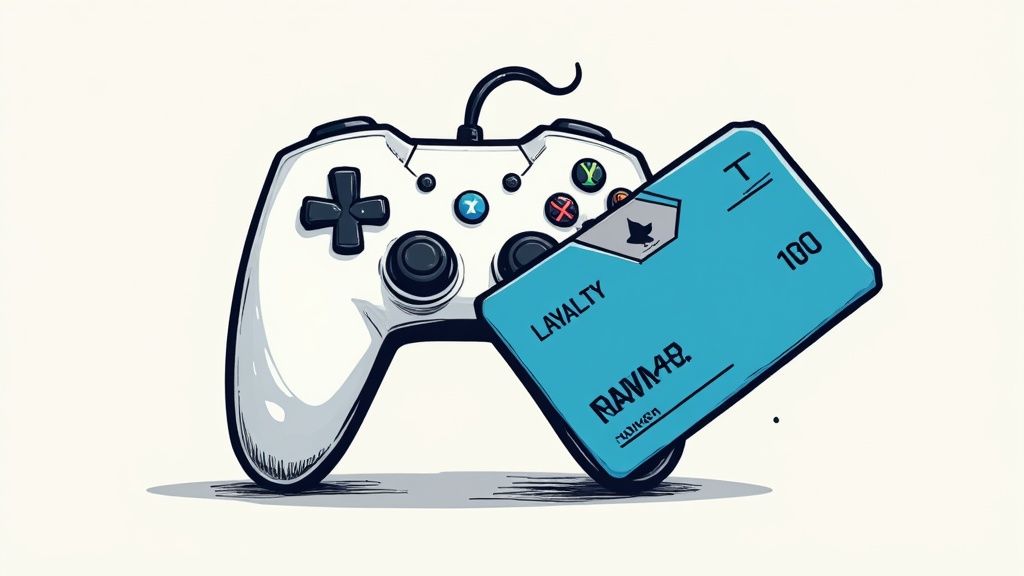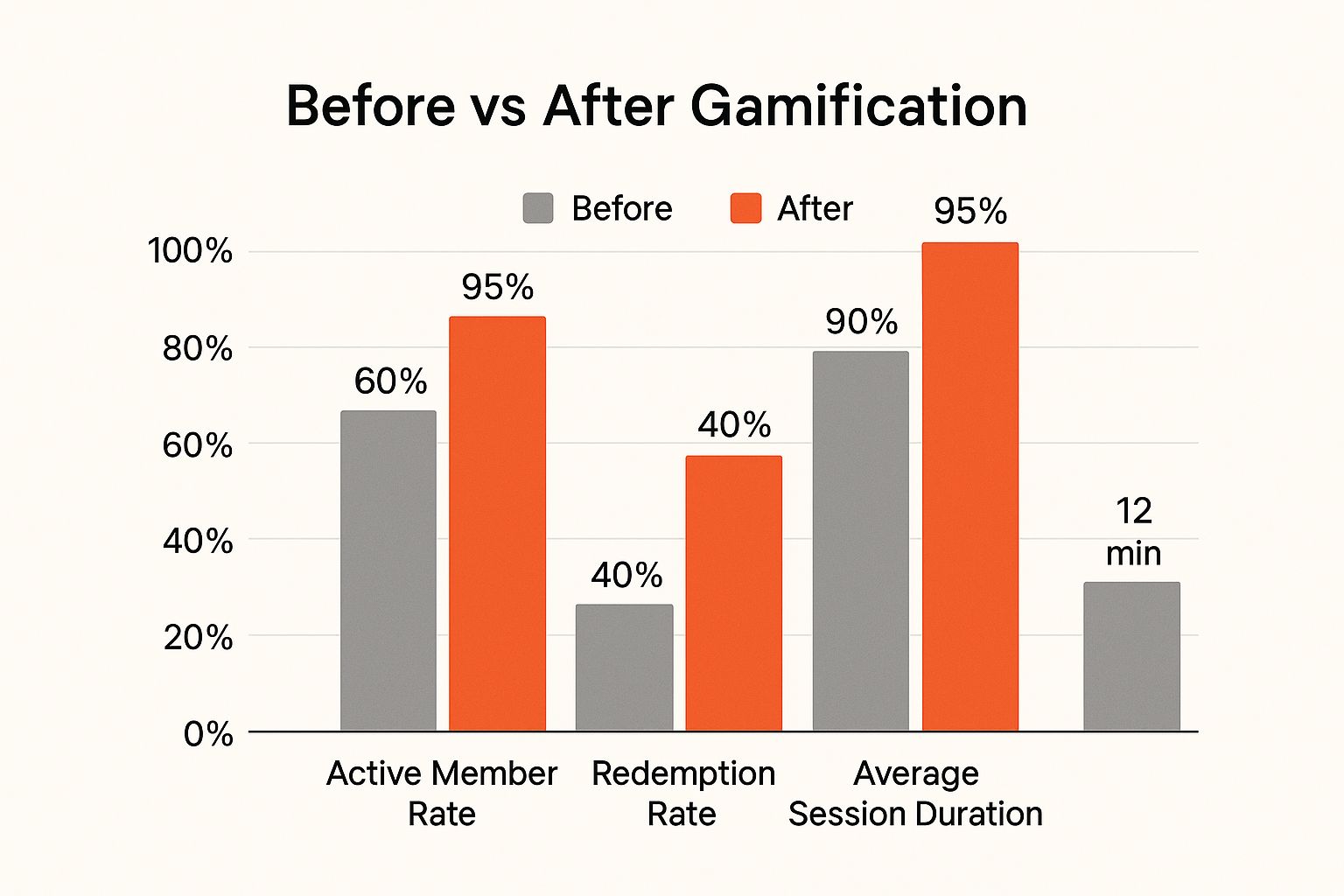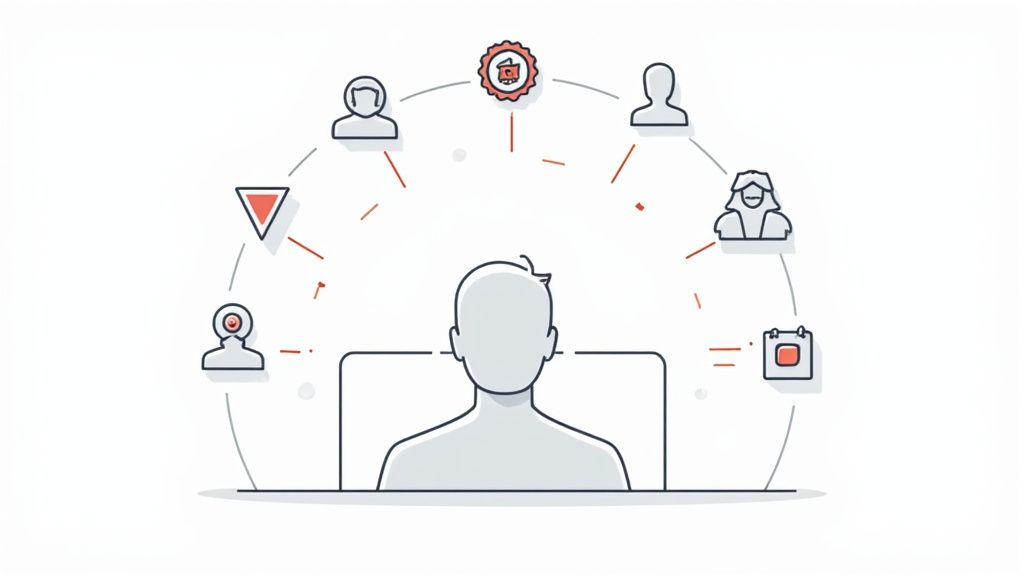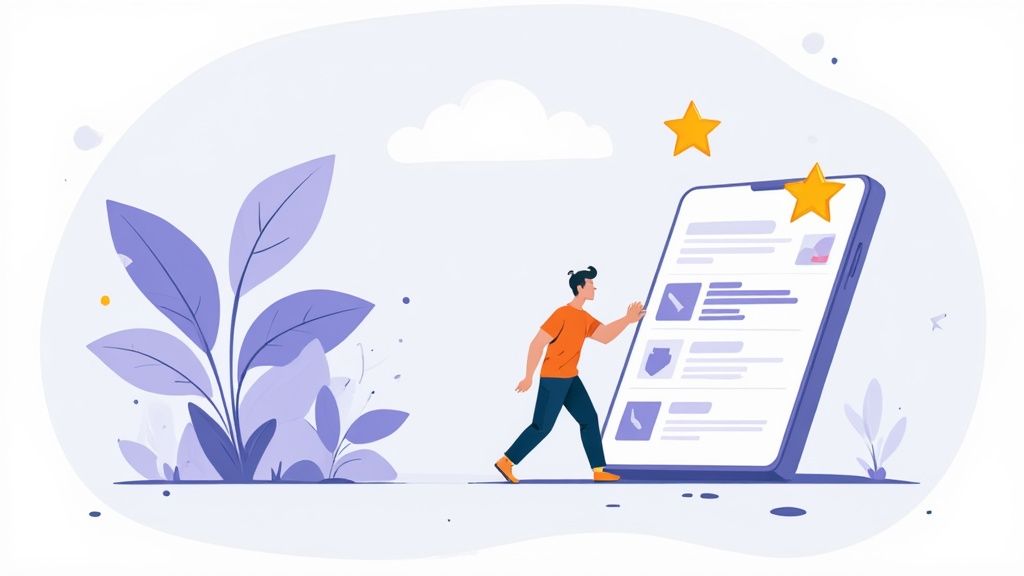Loyalty Program Gamification Tips to Boost Engagement
Why Loyalty Programs Need Gamification Now

Traditional loyalty programs, based on simple point accumulation, are struggling to hold customer attention. Many consumers find these programs passive and unexciting, resulting in low engagement and ultimately, reduced returns. This is where gamification enters the picture. Forward-thinking businesses are transforming their loyalty programs from passive point-collection systems into interactive experiences that resonate with today's consumers.
This shift is driven by a fundamental change in customer expectations. Modern consumers desire engaging experiences, not just transactional rewards. They want to feel a sense of achievement, status, and connection with the brands they patronize.
Gamification, by incorporating elements like:
- Challenges
- Leaderboards
- Badges
taps directly into these psychological needs.
For example, consider a coffee shop loyalty program that awards badges for trying different drinks or reaching certain spending milestones. This adds an element of fun and accomplishment, encouraging customers to return.
Additionally, gamification offers valuable data insights into customer behavior. By tracking user interactions within the gamified program, businesses gain a better understanding of customer preferences and buying habits. This data can personalize rewards, target marketing campaigns, and enhance the overall customer experience. Ultimately, businesses can refine their strategies to better meet customer needs, improving customer satisfaction and loyalty.
The Growth of the Gamification Market
The growing role of gamification in loyalty programs is evident in the market's substantial growth. In 2024, the global gamification market was valued at $43 billion. Projections suggest it will reach $172.4 billion by 2030, with a CAGR of 26.1%. This rapid expansion demonstrates gamification's effectiveness in boosting consumer engagement and driving tangible business results. Over 70% of businesses in the Global 2000 have already implemented gamification strategies. As competition increases, businesses that don't incorporate gamification into their loyalty programs risk falling behind. Learn more about this growth at Globenewswire. Companies using gamification are not just creating engaging loyalty programs; they're building stronger customer relationships that lead to sustained growth and a competitive advantage.
The Real ROI of Gamified Loyalty Programs
Loyalty program gamification isn't just a popular concept; it's a powerful strategy for achieving measurable business results. But what kind of return on investment (ROI) can you realistically anticipate? This section explores the impact of gamification on important metrics, using real-world performance data.
Quantifiable Benefits of Gamification
Analyzing successful loyalty programs reveals how gamification provides substantial improvements over traditional methods. For instance, gamified programs achieve 22% higher customer retention rates and engagement increases from 100% to 150%. This increased engagement leads to more repeat purchases and stronger brand loyalty, both essential for sustained growth. Research across various industries, including retail and fintech, supports this, highlighting gamification's effectiveness in engaging users and improving customer retention. Find more detailed statistics here. In essence, incorporating game mechanics helps businesses cultivate stronger, more profitable customer relationships. You might also be interested in learning more about the psychology of loyalty.
Visualizing the Impact
The following infographic visually represents how gamification affects key metrics such as active member rate, redemption rate, and average session duration.

As the infographic demonstrates, gamification can significantly boost active member participation (from 60% to 95%), increase redemption rates (from 40% to 90%), and improve user engagement, measured by average session duration (from 5 minutes to 12 minutes). These enhancements directly influence revenue generation and customer lifetime value.
The Psychology Behind Gamified Loyalty
Why is gamification so effective? It leverages fundamental principles of human psychology. Elements like status, achievement, and competition are key drivers.
-
Status: Tiered programs and leaderboards provide customers with a sense of value and recognition.
-
Achievement: Earning badges and completing challenges give customers a sense of accomplishment.
-
Competition: Contests and leaderboards encourage friendly rivalry, further driving engagement.
These psychological drivers create emotional connections between customers and brands, fostering loyalty and a sense of belonging. This, in turn, leads to increased customer lifetime value and strengthens brand advocacy.
Building a Compelling Business Case
To gain support from leadership, present a clear business case for gamified loyalty programs. Focus on the quantifiable benefits: increased retention, higher engagement, and ultimately, greater revenue.
The following table summarizes the impact of gamification on key loyalty metrics:
| Metric | Traditional Loyalty Programs | Gamified Loyalty Programs | Percentage Improvement |
|---|---|---|---|
| Customer Retention Rate | Assume 78% | 100% | 22% |
| Customer Engagement | Assume Baseline | 100-150% Increase from Baseline | 100-150% |
| Active Member Participation | 60% | 95% | 35% |
| Redemption Rate | 40% | 90% | 50% |
| Average Session Duration | 5 minutes | 12 minutes | 70% |
This table clearly illustrates the significant improvements observed across various metrics when comparing traditional and gamified loyalty programs. The data highlights the potential for substantial gains in customer engagement and retention through gamification.
Highlight how gamification aligns with overall business goals, whether it's increasing customer lifetime value, encouraging repeat purchases, or raising brand awareness. By demonstrating the measurable impact of gamification, you can build a strong argument for its adoption and showcase its strategic importance.
Game Mechanics That Actually Drive Loyalty

Not all gamification elements are created equal. Some mechanics resonate more with customers, leading to stronger engagement and increased loyalty. Choosing the right mechanics is essential for maximizing your loyalty program’s impact. By analyzing successful programs, we can pinpoint the mechanics that consistently deliver strong results.
Progress Bars and the Power of Completion
Progress bars appeal to our natural desire to finish what we start. Visually tracking progress toward a reward motivates customers to stay engaged with your brand. This simple mechanic can significantly improve purchase frequency and overall customer lifetime value.
For example, a coffee shop loyalty program could use a progress bar to track purchases toward a free drink. This encourages customers to return frequently to fill the bar and claim their reward. The closer they are to completion, the stronger their motivation.
Limited-Time Challenges and Urgency
Creating urgency is a strong motivator. Limited-time challenges introduce scarcity, encouraging customers to act quickly. This is particularly effective for promoting new products or increasing sales during specific periods.
Imagine a challenge to purchase three specific items within a week to unlock a special badge or discount. The limited time creates excitement and encourages immediate action. This boosts short-term sales and re-engages existing customers.
Personalized Achievements: Beyond Generic Badges
Generic badges, while offering a sense of accomplishment, often lack the personal touch needed for long-term engagement. Personalized achievement systems, however, resonate much more deeply. Tailoring achievements to individual preferences and behaviors creates a sense of unique recognition.
Instead of a standard "Frequent Buyer" badge, consider awarding badges for purchasing specific product categories or reaching milestones related to individual hobbies or interests. This personalization strengthens the emotional bond between the customer and your brand. For practical implementation tips, check out our guide on How to Master Gamification Within Your Loyalty Program.
Combining Mechanics for Maximum Impact
While individual mechanics can be effective, combining them can create a truly engaging loyalty program. Layering progress bars with limited-time challenges and personalized achievements creates a dynamic experience that appeals to various customer motivations.
Imagine a loyalty program where customers fill a progress bar by completing personalized challenges within a specific timeframe. This multifaceted approach maximizes engagement and strengthens long-term loyalty. The key is to carefully choose mechanics that complement each other and align with your overall business goals. This creates a cohesive and rewarding experience for your customers, encouraging continued participation and driving measurable results.
Success Stories: Brands Winning With Gamified Loyalty
Real-world examples demonstrate the power of gamification in loyalty programs. Let's explore how major brands have transformed their loyalty outcomes through strategic implementation of game mechanics.
McDonald's Monopoly: Driving Sales Through a Familiar Game
McDonald's Monopoly is a prime example of successful gamified loyalty. This promotion, leveraging the widely recognized board game, drives significant sales increases, often exceeding 5.6% during the promotional period. The program's success lies in its simplicity and familiarity. Customers collect game pieces, hoping to match properties and win prizes, from free food to cash. This creates excitement and encourages repeat visits, directly impacting revenue.
Starbucks Rewards: Progress-Based Engagement and Mobile Payments
Starbucks Rewards showcases the effectiveness of a progression-based system. Customers earn stars with each purchase, progressing through tiers to unlock better rewards. This tiered structure encourages repeat business and fosters a sense of accomplishment. The program has boosted Starbucks' mobile payment adoption to 40% of transactions, streamlining purchases and providing valuable data insights. By seamlessly integrating gamification with mobile payments, Starbucks has enhanced customer convenience and strengthened loyalty. You might be interested in: How Starbucks uses loyalty rewards programs.
Nike Run Club: Fostering Community and Achievement Through Fitness
Nike Run Club exemplifies how gamification can build community and encourage specific behaviors. This app-based program tracks users' runs, awarding virtual badges and trophies for achieving distance milestones. It also fosters a sense of community by allowing users to connect with friends, share progress, and participate in virtual challenges. With an impressive 85% monthly active user rate, Nike Run Club demonstrates how aligning gamification with a brand's core values can create a highly engaged and loyal customer base.
Maintaining Program Freshness and Evolving Approaches
The growth and adoption of gamification in loyalty programs are closely tied to broader industry trends. The global loyalty programs market is expanding rapidly, projected to grow at 15.9% annually. This growth is fueled by technologies like AI-powered personalization, mobile-first engagement, and gamification. McDonald's Monopoly, for example, remains a top-performing interactive loyalty initiative. The increasing use of digital and mobile technologies has transformed loyalty programs, with app-based ecosystems replacing traditional methods. This underscores the importance of gamification in creating engaging, real-time experiences that enhance customer loyalty and retention. Find more detailed statistics here. These brands understand that maintaining excitement requires continuous evolution. They regularly introduce new challenges, update rewards, and incorporate fresh content to prevent their programs from becoming stale. This ongoing evolution is key to sustained engagement and long-term loyalty.
These examples highlight the versatility of loyalty program gamification across different industries. Whether you're in retail, hospitality, financial services, or B2B, these success stories offer valuable insights for building a program that resonates with your target audience and drives measurable results. By learning from these brands, you can create a gamified loyalty program that not only rewards customers but also strengthens their connection with your brand.
Building Your Gamified Loyalty Program: A Roadmap

Turning a gamified loyalty program concept into a working reality needs a structured plan. This section offers a practical roadmap, outlining the process of building a successful program, from initial strategy to post-launch improvements. It includes realistic timelines, resource needs, and addresses typical challenges.
Defining Your Objectives and Aligning With Business Goals
First, clearly define what you hope to achieve with your loyalty program gamification. These objectives should directly support your overall business goals.
For example, if increasing customer lifetime value is your goal, your loyalty program should use mechanics that encourage repeat purchases and build long-term engagement.
Selecting the Right Game Mechanics for Your Audience
Choosing the right game mechanics is critical. Different mechanics work better with different audiences.
Consider your target demographic, their preferences, and motivations. Do they like competition? Are they driven by achievement? Knowing your audience will help you choose the most effective game mechanics.
Integrating With Existing Systems: Avoiding Technical Nightmares
Smooth integration with your current systems is key. This minimizes disruptions and boosts efficiency.
Select a loyalty program platform, such as Toki, that seamlessly integrates with your existing CRM, POS, and e-commerce platforms. This prevents technical issues and ensures a cohesive customer experience.
Building Cross-Functional Support and Securing Buy-In
A successful loyalty program requires buy-in from various departments, from marketing to IT. Explain the benefits of gamification throughout your organization, emphasizing how it contributes to shared goals.
This fosters collaboration and ensures smooth implementation.
Testing and Optimization: Refining Your Gamified Program
Thorough testing is crucial before launch. Test your program with a small customer group to get feedback and find any problems.
This lets you fine-tune the program and ensure a positive customer experience at full launch.
Measuring Success: Tracking Engagement and Business Outcomes
Set clear metrics for measuring your program's success. Track both engagement metrics (like active users and challenge completion rates) and business outcomes (like customer retention and average order value).
This provides valuable data for ongoing optimization and shows the ROI of your gamified loyalty program.
Addressing Common Challenges: Budget, Buy-In, and Technical Limitations
Launching a new loyalty program can present challenges. Limited budgets, getting executive buy-in, and dealing with technical limitations are common obstacles.
By proactively addressing these issues with clear communication and strategic planning, you can overcome these challenges effectively.
Implementation Timeline and Resource Allocation
The following table, "Loyalty Program Gamification Implementation Timeline," details the implementation phases, activities, and typical timeframes. It provides a clear overview of the resources required for each stage, helping you plan effectively.
| Phase | Key Activities | Typical Duration | Required Resources |
|---|---|---|---|
| Planning & Strategy | Define objectives, target audience, and game mechanics | 4-6 weeks | Marketing, Product, IT |
| Development & Integration | Platform setup, game mechanics implementation, system integration | 8-12 weeks | IT, Development, Loyalty Program Manager |
| Testing & Refinement | Pilot program launch, user feedback collection, program adjustments | 4-6 weeks | QA, Customer Service |
| Launch & Promotion | Full program rollout, marketing campaign execution, initial performance monitoring | 2-4 weeks | Marketing, PR |
| Ongoing Optimization | Performance analysis, program adjustments, new feature implementation | Continuous | Loyalty Program Manager, Marketing, IT |
This table highlights the importance of cross-functional collaboration, especially during the development and integration phase. Ongoing optimization ensures the program remains effective and relevant.
This roadmap provides a framework for building a successful gamified loyalty program. By following these steps and proactively addressing potential challenges, you can create a program that engages customers, builds loyalty, and drives measurable business results. Tools like Toki can significantly streamline this process and offer the features needed to create a comprehensive and engaging loyalty program.
Avoiding the Gamification Pitfalls That Kill Programs
Loyalty program gamification offers significant benefits, but it can backfire if not implemented strategically. Learning from others' mistakes can save valuable time and resources. This section analyzes why some gamified loyalty initiatives fail, drawing insights from program managers' post-mortem analyses.
Complexity Overload: Keeping It Simple
Overly complex programs can confuse and frustrate customers. Too many rules, tiers, or challenges can quickly overwhelm participants and discourage engagement. A program should be intuitive and easy to understand. Think of a simple game like collecting stamps for a free coffee – everyone understands the rules. Your loyalty program should offer similarly clear, straightforward mechanics.
Insufficient Rewards: Motivating Participation
Rewards must justify the effort. If rewards are perceived as insignificant or unattainable, customers lose their motivation to participate. For instance, offering a small discount after numerous purchases won't generate much excitement. Consider tiered rewards, increasing in value with customer engagement, much like unlocking new levels in a video game.
Neglecting Mobile Optimization: Reaching Your Customers
In our mobile-centric world, neglecting mobile optimization is a critical error. Customers expect seamless access to their loyalty program through their smartphones. A poorly designed mobile experience almost guarantees low adoption and minimal interaction. Ensure your loyalty program is accessible and user-friendly across all devices. Toki focuses on seamless mobile integration, ensuring customers can easily engage with your program anytime, anywhere.
Maintaining Engagement: Keeping It Fresh
Even well-designed programs can become stale over time. Continuously refresh your content and introduce new challenges to maintain customer interest. Think of successful games that regularly release updates and expansions. Your loyalty program should similarly evolve to keep customers engaged and excited.
Fairness and Recognizing High-Value Customers
Balancing fairness across all customer segments while still rewarding your most valuable customers is essential. Consider a tiered system where all customers earn rewards, but high-value customers unlock premium benefits. This approach ensures all participants feel valued while simultaneously incentivizing greater spending.
Practical Strategies for Avoiding Pitfalls
-
Thorough Audience Research: Understand your target audience's preferences and motivations. This helps tailor your gamification mechanics to maximize engagement.
-
Balanced Incentive Structures: Ensure rewards are appealing and proportionate to the effort required.
-
Strategic Testing Protocols: Before launching, test your program with a small group to identify any potential issues and refine the user experience.
-
Regular Content Refreshes: Keep your program fresh with new challenges, rewards, and content updates.
-
Evolving Challenges: Introduce new game mechanics and challenges to maintain excitement and prevent stagnation.
By understanding these common pitfalls and implementing these strategies, you can create a gamified loyalty program that effectively engages customers, strengthens their connection with your brand, and drives tangible business results.
Future-Proofing Your Loyalty Program Gamification
Consumer behavior is constantly changing, and so should your loyalty program. To remain engaging and relevant, continuous adaptation and innovation are key. This section explores the future of loyalty program gamification, looking at emerging technologies and strategies brands are using to stay ahead of the curve. By preparing now, you can ensure your program remains attractive and effective for years to come.
Emerging Technologies: The Next Level of Gamification
Imagine customers using their phones to unlock exclusive content or participating in augmented reality (AR) challenges inside your store. AR overlays digital experiences onto the real world, offering exciting possibilities for loyalty programs. This interactive approach can drive foot traffic, encourage product discovery, and create memorable brand experiences, bridging the physical and digital worlds for deeper customer engagement.
Blockchain technology provides a secure and transparent way to manage rewards. This allows customers to truly own their rewards and even trade them with others, increasing your program's value. Blockchain's transparency builds trust and encourages participation, creating a more engaging and rewarding loyalty experience.
The expanding Internet of Things (IoT) ecosystem also presents exciting opportunities. Connected devices can track customer behaviors and automatically award points, creating a seamless and personalized loyalty experience. This automated engagement enhances the customer journey, rewarding loyalty effortlessly.
AI Personalization: Tailoring the Game Experience
Artificial intelligence (AI) is revolutionizing loyalty program gamification through hyper-personalization. AI algorithms analyze individual customer preferences and behavior to customize game mechanics and rewards. Imagine challenges and rewards perfectly aligned with a customer's past purchases and interests. This dynamic approach keeps customers engaged and motivated with relevant and appealing experiences.
The Power of Social Connection
Loyalty programs are no longer solely about individual rewards; they're increasingly incorporating social elements. This might include team-based challenges, community forums, or social sharing features that allow customers to connect and share their progress. These social interactions transform the loyalty experience from a solo activity into a shared community experience, strengthening customer relationships and fostering brand advocacy.
Preparing for the Future: Practical Steps
How can you prepare your program architecture for these innovations? A phased approach is often the most effective, allowing you to test new features without a complete system overhaul.
-
Modular Design: A flexible, modular system allows easy integration of new technologies as they emerge. This adaptability is essential for staying ahead of trends and meeting changing customer expectations.
-
Data Integration: Collecting and analyzing customer data is critical for personalization. Ensure your system can effectively capture and use data from various touchpoints, like online purchases, in-store visits, and app interactions. Toki offers robust analytics and data integration capabilities to support this.
-
Experimentation and Testing: Don't hesitate to experiment with new technologies and game mechanics. A culture of testing and iteration helps you discover what resonates with your audience.
By embracing these strategies, you can create a future-proof loyalty program that continuously attracts, engages, and retains customers in a dynamic market. Adaptability and innovation are essential for maintaining program relevance and maximizing customer lifetime value.
Ready to build a next-generation loyalty program that drives repeat business and strengthens customer relationships? Explore Toki’s comprehensive features and start your free trial today: Discover Toki